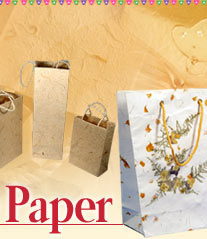|
|
Invention of paper as we know it today is attributed to the T'sai Lun Chief eunuch, of Emperor Ho-Ti's of the Han dynasty. It is said that T'sai Lun experimented with different materials and developed the art macerating the fibre of plants until each strand was separated. These separated fibres were mixed with water in a huge vat and a screen was dipped into the vat and lifted through the water, which caught the fibres on its surface. This layer of intertwined fibre was dried and product that was formed was paper. The paper was thin, flexible and strong and had a fine smooth surface and T'sai Lun was respected as the patron saint of papermaking.
The process of making paper was kept a secret within China till the 3rd century then it spread to Vietnam and then to Tibet. Paper was introduced in Korea in the 4th century and to Japan in the 6th century. Then it spread slowly to Asia and Nepal. In 751AD when the Tang dynasty was at war with the Muslim rulers on the banks of the Tarus River. The Muslims captured a Chinese caravan that had many papermakers as well. They were taken to Samarkand and they taught the Muslims how to make paper and eventually Samarkand became an important center for the production of paper. From here the paper makers moved west to Baghdad, Damascus and Cairo. When the Moors of North Africa attacked Spain and Portugal they took the paper making technique with them and papermaking finally found its way to Europe in the 12th century.




